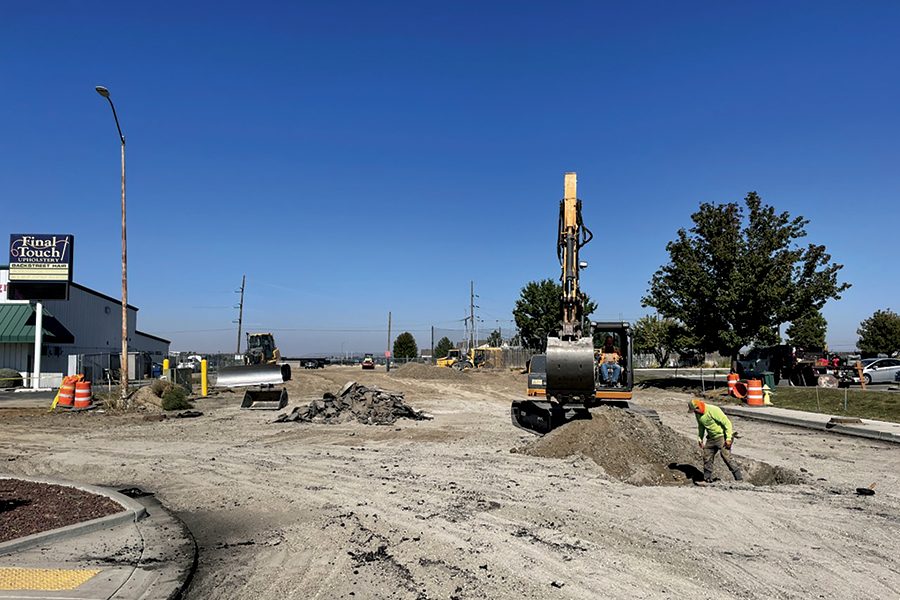
Home » It took 22 years, but Center Parkway ‘punch through’ has started
It took 22 years, but Center Parkway ‘punch through’ has started

October 14, 2022
A critical connection between Kennewick and Richland is being built after more than two decades of planning and litigation.
Center Parkway is being extended across a Port of Benton-owned railroad track near Columbia Center mall. When the two sides connect, motorists will be able to drive from Gage Boulevard in Kennewick to Tapteal Drive in Richland.
The extension will ease traffic in the Kennewick-Richland border zone west of Columbia Center and unused land on Tapteal Drive for development. Flex space buildings offering 30 warehouse/office spaces are under construction nearby.
The road project took 22 years and more than $3 million in design work, acquiring property rights and securing permission to cross the railroad tracks to get started. Premier Excavation, the contractor, bid $1.8 million to construct it.
The extension is expected to open in late summer 2023 at a total cost of around $6 million.
Pete Rogalsky, the city’s longtime public works director, remarked on the challenges of extending a road over the railroad tracks – the former rail operator objected in a series of court challenges – during a ribbon-cutting ceremony on Sept. 28.
“I’ve been working on this for a while,” he said. “One of the things the city brings to this project is stubbornness.”
The most visible sign of construction occurred in September, when Premier, the contractor, demolished the building that was the longtime home of Mail by the Mall and a warehouse business. Richland purchased the site. Mail by the Mall moved to leased space at 1360 N. Louisiana St., Suite A, near Olive Garden, in June.
With the building out of the way, Premier’s excavators moved in to carve a road across the former no-man’s land. Previously, Center Parkway deadended on the Kennewick side at Mail by the Mall and on the Richland side at a Holiday Inn. Tapteal Drive is home to Kohl’s, furniture stores, hotels and a future Carmax but access is awkward.
The city sees an opportunity to activate 33 acres and spark private investment that could deposit 900 jobs in the neighborhood.
The extension is actually straightforward.
That’s how it looked in 2001, when the two cities saw the need to connect the area divided by the railroad tracks behind Columbia Center.
Kennewick took the lead to start, then handed it off to Richland.
The Transportation Improvement Board, a state agency that doles out gas tax money for road improvement projects, approved money for the project years ago, said Ashley Probart, executive director. He recalled it as a simple undertaking – a simple “punch through.”
Probart said TIB projects typically move quickly from funding to completion. But Center Parkway stayed on the to-do list while the promoters battled the Tri-City Railroad, which objected to the road crossing the tracks it leased from the port. TIB funded 11 dozen other projects for Richland and saw them to fruition.
“It’s overdue and it’s time to get it done,” Probart said. As an aside, Probart said TIB requires regular updates for projects on its list. Rogalsky gave about 60 of them, he estimated.
Tri-City Railroad’s legal saga ended this year when the port evicted it over lack of maintenance after winning a lawsuit in Benton County Superior Court.
Kennewick Mayor Bill McKay lamented the long delay.
“That is what frustrates me about government, that it takes that long to complete a project,” he said at the ribbon cutting ceremony.
In addition to TIB gas tax money, Center Parkway is being funded by the Benton County Rural Capital Fund, which invests an 0.09% sales tax rebate from the state into projects that benefit local communities. The fund committed $2.8 million to the project.
The delay gave officials a chance to redesign it after a regional assessment concluded bikes and pedestrians were underserved in the area.
It was redesigned to be friendlier to both and will eventually connect to a pedestrian and bicycle bridge that will cross Highway 240 near Columbia Center Boulevard, further connecting the area to Columbia Park to the north.
The final design features a three-lane roadway with bike lanes, curbs, gutters and sidewalks on both sides. The railroad crossing will be signalized with crossing gates.
Local News
KEYWORDS october 2022




